To install a water heater blanket, follow these steps: First, turn off the power supply to the water heater. Then, wrap the blanket around the water heater, making sure to leave the controls and access panels uncovered.
Staple or tape the ends of the blanket together securely, and turn the power back on. Done! When it comes to improving the energy efficiency of your water heater, installing a water heater blanket can be a simple yet effective solution.
By insulating the tank, a water heater blanket can help reduce heat loss and lower your energy consumption, ultimately saving you money on your utility bills. In this guide, we will walk you through the steps to install a water heater blanket, ensuring that you can do it easily and quickly. So, let’s get started and make your water heater more energy-efficient in no time.
Understanding Water Heater Blankets
What is a water heater blanket?
A water heater blanket is an insulation device that wraps around your water heater to reduce heat loss, improve energy efficiency, and save you money on your utility bills. It is typically made of fiberglass or foam insulation and fits snugly around the tank, providing an extra layer of insulation to prevent heat from escaping.
Why should you install a water heater blanket?
Installing a water heater blanket is a simple and cost-effective way to improve the energy efficiency of your water heater. By reducing the amount of heat that escapes from the tank, the blanket helps your water heater to maintain its temperature more efficiently, resulting in less energy being wasted. This can lead to significant savings on your monthly energy bills. Additionally, adding insulation to your water heater can extend its lifespan by reducing the strain on its components.
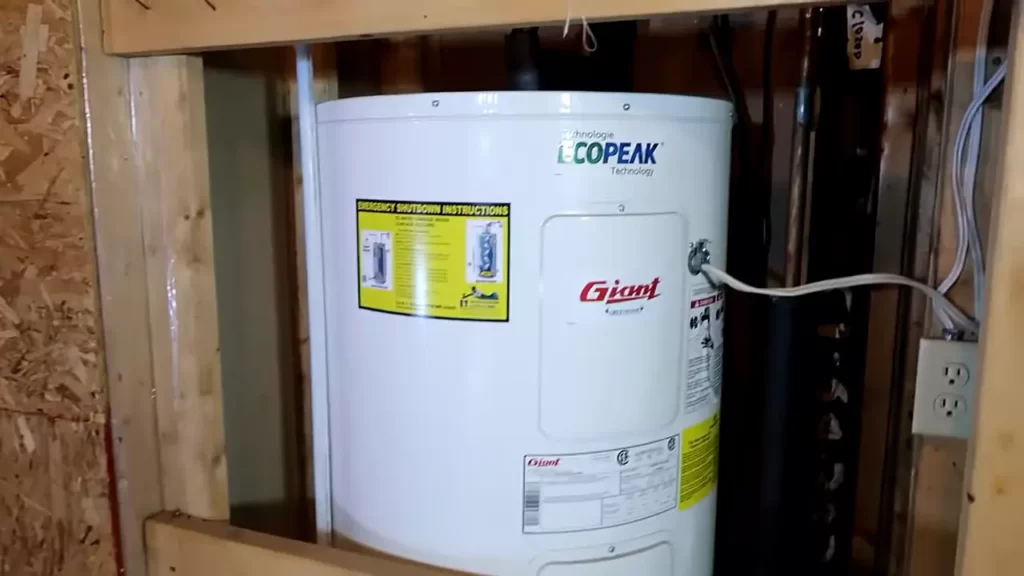
Benefits of using a water heater blanket
Using a water heater blanket offers several benefits:
- Energy savings: By reducing heat loss, a water heater blanket can help you save money on your energy bills. It acts as a barrier, keeping heat trapped within the tank and reducing the need for the water heater to constantly reheat the water.
- Improved efficiency: With a water heater blanket, your water heater doesn’t have to work as hard to maintain the desired temperature, resulting in improved efficiency. This can lead to lower energy consumption and reduced greenhouse gas emissions.
- Extended lifespan: The added insulation provided by a water heater blanket reduces the strain on the components of your water heater. This can help prolong its lifespan and save you from costly repairs or replacements.
- Eco-friendly: By reducing energy consumption, using a water heater blanket contributes to a more sustainable environment by reducing greenhouse gas emissions.
- Quick and easy installation: Installing a water heater blanket is a straightforward DIY project that requires minimal tools and time. Most blankets come with easy-to-follow instructions and can be installed within minutes.
In conclusion, a water heater blanket is a practical and cost-effective solution to improve the energy efficiency of your water heater. With its numerous benefits, including energy savings, improved efficiency, extended lifespan, and eco-friendliness, investing in a water heater blanket is a wise choice for any homeowner.
Assessing Your Water Heater
How to determine if your water heater needs a blanket?
Assessing your water heater is crucial before you go ahead and install a water heater blanket. By evaluating your water heater, you can determine if it needs additional insulation. This step ensures that you are making the most efficient and cost-effective choice for your home’s hot water needs. Here are some simple steps to help you assess your water heater:
- Check the size and type of your water heater
- Measure the water heater tank insulation level
Checking the size and type of your water heater
The first step in assessing your water heater is to check its size and type. This information helps you determine if your water heater needs a blanket and what size it should be. Here’s how you can determine these details:
- Locate the manufacturer’s label on your water heater
- Identify the size of your water heater, usually measured in gallons
- Note down the type of your water heater, whether it’s electric, gas, or tankless
Measuring the water heater tank insulation level
Another important aspect to consider when assessing your water heater is its current insulation level. This measurement helps determine if your water heater will benefit from the installation of a blanket. Follow these steps to measure the insulation level:
- Inspect the exterior of your water heater for an insulation R-value
- If you cannot find the R-value, carefully touch the tank to feel its temperature
- A warm tank indicates insufficient insulation, while a hot tank suggests that your water heater might benefit from additional insulation
By following these steps to assess your water heater, you can confidently determine if it needs a blanket to improve its energy efficiency. Ensure you gather accurate information about the size, type, and insulation level of your water heater before moving forward with the installation process.
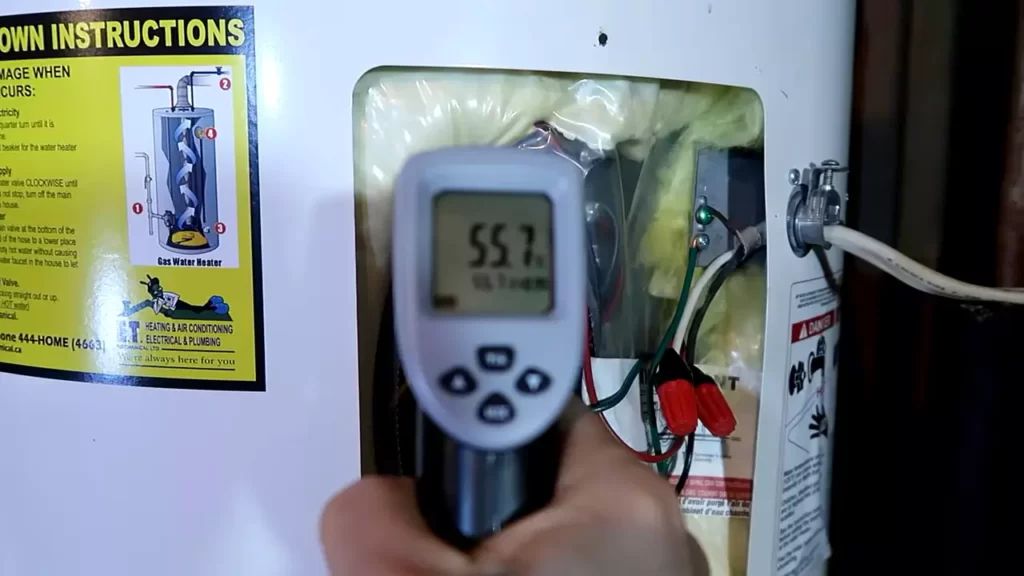
Choosing The Right Water Heater Blanket
Installing a water heater blanket is a cost-effective way to improve the energy efficiency of your water heater. Not only will it help reduce heat loss, but it can also lower your energy bills. However, choosing the right water heater blanket is key to maximizing these benefits. In this section, we will explore the factors to consider, how to determine the appropriate R-value, and the different types of water heater blankets available.
Factors to consider when selecting a water heater blanket
Before purchasing a water heater blanket, there are a few factors to take into consideration. These factors can help guide you toward the most suitable option for your specific needs:
- Size: Measure the dimensions of your water heater to ensure the blanket will fit properly.
- Material: Water heater blankets are typically made from fiberglass, foil, or a combination of both. Each material offers its own advantages, such as insulation capabilities and resistance to moisture or fire.
- Thickness: The thickness of the blanket determines its R-value, which measures the insulation effectiveness. We will dive deeper into determining the appropriate R-value in the following section.
- Installation: Consider whether the blanket comes with easy-to-follow installation instructions and necessary accessories.
- Budget: While cost-effective, the price range of water heater blankets can vary. Determine your budget and find a blanket that offers good value for money.
Determining the appropriate R-value for your water heater
The R-value, or thermal resistance, of a water heater blanket is an important factor to consider. It indicates how well the blanket can insulate against heat loss. The appropriate R-value depends on your water heater’s location and the climate in your area. As a general guideline:
- Warmer climates: In areas with consistently warmer temperatures, a water heater blanket with an R-value of around R-6 is usually sufficient.
- Colder climates: In colder regions where heating requirements are higher, consider a water heater blanket with an R-value of at least R-11 or higher to maximize energy savings.
Keep in mind that local building codes or energy efficiency recommendations might specify a particular R-value for water heater insulation. Check these guidelines to ensure compliance and optimal energy efficiency.
Different types of water heater blankets available
Water heater blankets come in various types, each with its own unique features:
| Type | Description |
|---|---|
| Fiberglass blankets | These blankets are cost-effective and widely available. They are easy to install and offer good insulation capabilities. |
| Foil reflective blankets | These blankets feature a reflective surface that helps redirect radiant heat back into the water tank. They are especially effective in hot climates. |
| Combination blankets | These blankets combine both fiberglass insulation and a reflective foil surface. They offer the benefits of both types and provide enhanced insulation properties. |
Consider your specific needs and the characteristics of each type when selecting the most suitable water heater blanket for your water heater.
By taking into account factors such as size, material, thickness, installation, and budget, as well as determining the appropriate R-value and exploring the different types available, you can confidently choose the right water heater blanket for improved energy efficiency and reduced energy costs.
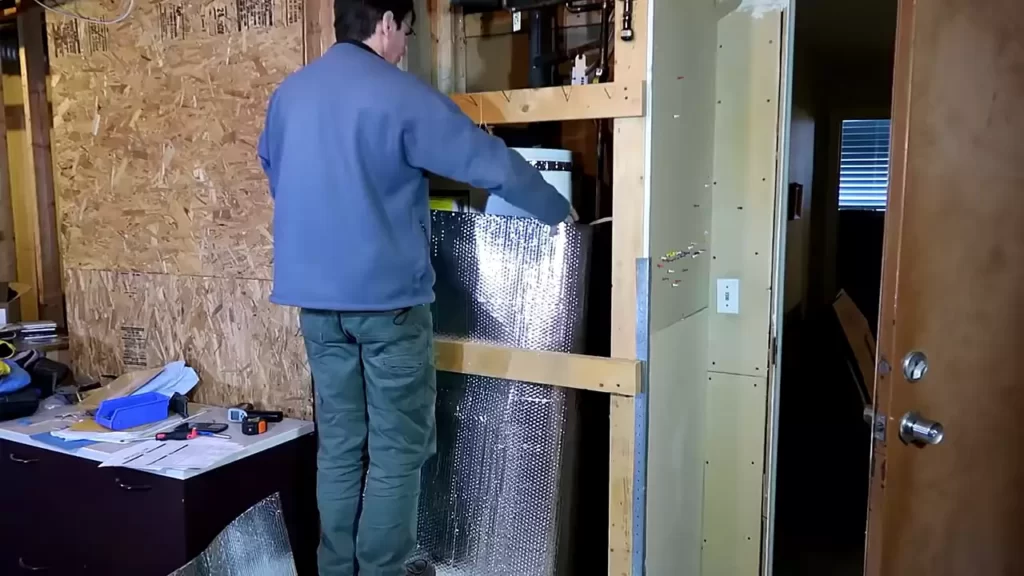
Step-By-Step Guide To Installing A Water Heater Blanket
Installing a water heater blanket is a simple and effective way to reduce heat loss, improve energy efficiency, and save on your utility bills. In this step-by-step guide, we will walk you through the process of installing a water heater blanket, from gathering the necessary tools and materials to testing the water heater after installation. By following these steps, you can easily install a water heater blanket and start enjoying the benefits of a more energy-efficient home.
Gathering the necessary tools and materials
Before you begin the installation, it’s important to gather all the necessary tools and materials. Here’s a list of what you’ll need:
| Tools | Materials |
|---|---|
|
|
Preparing the water heater and the surrounding area
Before installing the water heater blanket, it’s essential to prepare the water heater and the surrounding area. Follow these steps:
- Turn off the power to the water heater from the circuit breaker or switch off the gas supply.
- Make sure the water heater is cool to the touch.
- Clean the surface of the water heater tank to remove any dirt or debris.
- Clear the area around the water heater, ensuring there are no obstructions.
Measuring and cutting the blanket to fit the water heater
Now it’s time to measure and cut the water heater blanket to fit the tank perfectly. Here’s how:
- Measure the height and circumference of the water heater tank using a measuring tape.
- Transfer the measurements to the water heater blanket, ensuring an allowance for overlapping.
- Cut the water heater blanket along the marked lines using scissors or a utility knife.
Wrapping and securing the blanket around the tank
With the blanket cut to size, it’s time to wrap and secure it around the water heater tank. Follow these steps:
- Start at the top of the tank and wrap the blanket tightly around it.
- Use duct tape to secure the ends of the blanket together.
- Continue wrapping the blanket around the tank, ensuring a snug fit.
- Use additional duct tape to secure the blanket in place, making sure it doesn’t sag or shift.
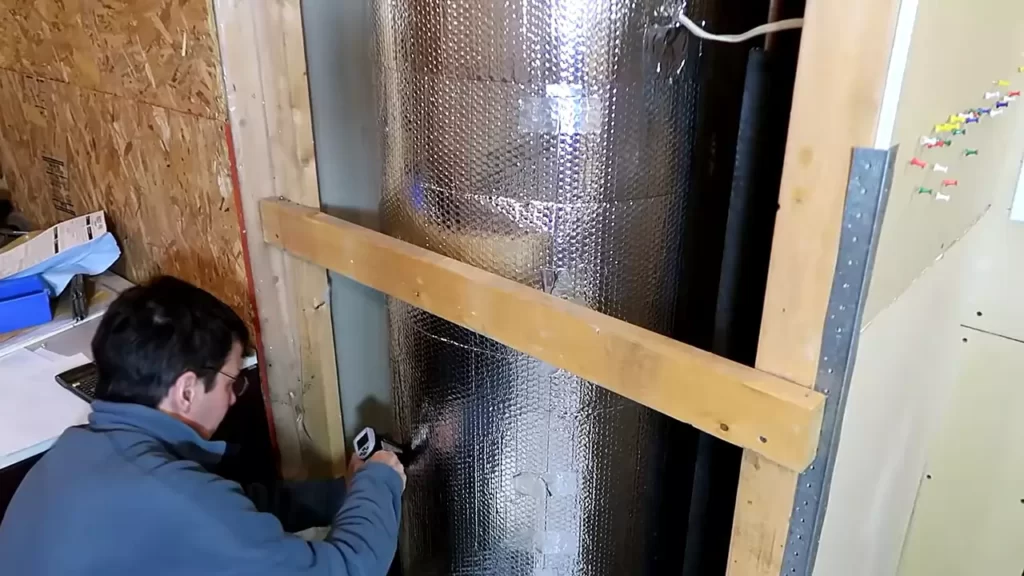
Insulating the pipes and fittings
While the water heater blanket helps reduce heat loss from the tank, it’s also essential to insulate the pipes and fittings to maximize energy efficiency. Here’s what you need to do:
- Measure the length of the exposed hot and cold water pipes, as well as any fittings.
- Cut the insulation tape or pipe sleeves to the appropriate lengths.
- Wrap the insulation tape or slide the pipe sleeves over the pipes and fittings, covering them completely.
- Secure the insulation tape or pipe sleeves in place with duct tape if needed.
Testing the water heater after installation
Once you have installed the water heater blanket and insulated the pipes, it’s important to test the water heater to ensure everything is working correctly. Follow these steps:
- Turn the power back on at the circuit breaker or switch on the gas supply.
- Wait for the water heater to heat up and reach the desired temperature.
- Check for any leaks or issues with the water heater and the insulated pipes.
- Make any necessary adjustments or repairs to ensure proper functionality.
By following this step-by-step guide, you can install a water heater blanket and insulate your pipes with ease. This simple DIY project will help make your home more energy-efficient and reduce your utility bills, all while providing you with consistent and reliable hot water.
Common Mistakes To Avoid
When it comes to installing a water heater blanket, there are several common mistakes that homeowners often make. These mistakes can lead to reduced efficiency and even potential hazards. To ensure a successful installation, it’s crucial to avoid the following errors:
Not Following the Manufacturer’s Instructions
One of the most common mistakes when installing a water heater blanket is not following the manufacturer’s instructions. Each water heater model may have specific requirements and guidelines that need to be followed for proper installation. Neglecting these instructions can result in an ineffective or improperly installed blanket, defeating the purpose of this energy-saving measure.
Using an Incompatible or Poor-Quality Blanket
Another mistake to avoid is using an incompatible or poor-quality blanket. It’s important to choose a blanket that is designed for your specific water heater model. Using a blanket that doesn’t fit properly or doesn’t provide adequate insulation can lead to reduced efficiency and potential safety risks. Opting for a high-quality blanket will ensure better insulation and maximum energy savings.
Improperly Installing the Blanket, Leading to Reduced Efficiency
Improper installation is a common error that many homeowners make when installing a water heater blanket. Failing to properly secure and position the blanket can result in reduced efficiency. This occurs when heat escapes through gaps or the blanket traps moisture, hindering its insulating properties. To avoid this mistake, make sure to carefully follow the installation instructions and double-check the fit and placement of the blanket.
Neglecting to Insulate the Pipes and Fittings
A crucial yet often overlooked step during a water heater blanket installation is insulating the pipes and fittings. Insulating these components helps to maintain the heat transfer efficiency of the water heater. Neglecting to insulate the pipes and fittings can lead to heat loss and decrease the overall effectiveness of the blanket. By insulating the pipes and fittings, you can ensure optimal energy conservation and performance of your water heater.
By avoiding these common mistakes, you can ensure a successful installation of a water heater blanket. Following the manufacturer’s instructions, using a compatible and high-quality blanket, properly installing the blanket, and insulating the pipes and fittings will maximize energy savings and enhance the efficiency of your water heater.
Maintenance And Troubleshooting Tips
Proper maintenance and troubleshooting are essential for ensuring the optimal performance and longevity of your water heater blanket. By regularly checking for signs of wear or damage, cleaning and replacing the blanket as needed, addressing common issues, and hiring a professional for repairs and maintenance, you can keep your water heater running efficiently. Here are some key tips to help you in this crucial process:
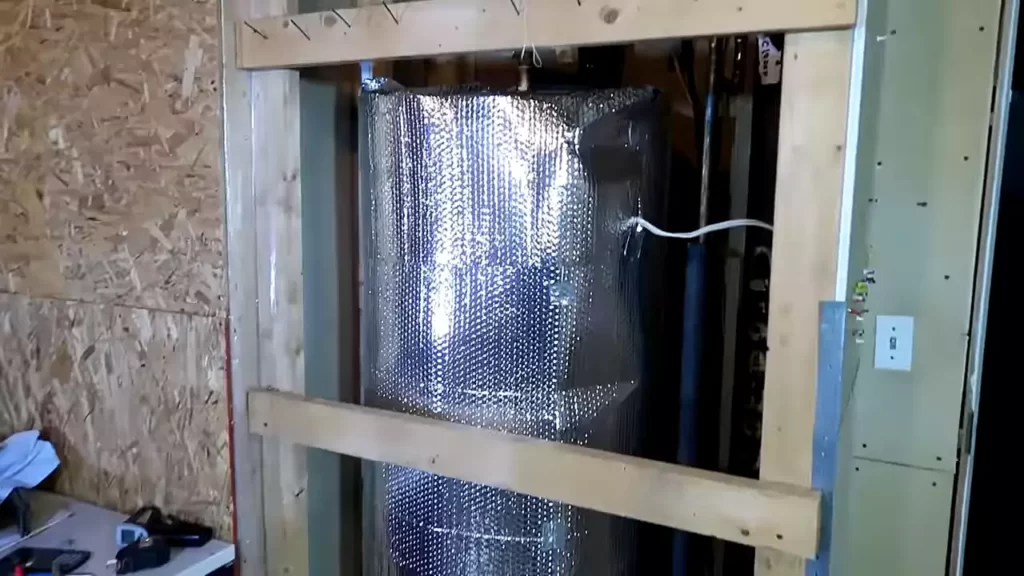
Regularly Checking for Signs of Wear or Damage
Regularly inspecting your water heater blanket for signs of wear or damage is vital to its effectiveness. Keep an eye out for any tears, rips, or deteriorating sections in the blanket. If you notice any such signs, it’s important to act promptly to avoid any further damage or compromised insulation. By addressing these issues early on, you can prevent energy loss and maintain optimal performance.
Cleaning and Replacing the Blanket as Needed
Cleaning your water heater blanket is essential to remove any accumulated dirt, dust, or debris. This not only helps to improve its insulation properties but also ensures that it functions optimally. You can gently vacuum or wipe the blanket with a damp cloth to remove any dirt or residue. Additionally, if the blanket becomes worn out or damaged beyond repair, it’s crucial to replace it with a new one. This will ensure the continued performance and efficiency of your water heater.
Addressing Common Issues with Water Heater Blankets
Water heater blankets may sometimes encounter common issues that can affect their functionality. One such issue is improper installation, which can lead to inadequate coverage or insulation gaps. Make sure the blanket is properly fitted and covers the entire surface of the water heater for maximum effectiveness. Additionally, if you notice any signs of overheating or heat loss, it may indicate that the blanket is not providing sufficient insulation. In such cases, consider upgrading to a higher-quality blanket or seek professional advice.
Hiring a Professional for Repairs and Maintenance
While some maintenance tasks can be managed by homeowners, it’s often beneficial to hire a professional for repairs and maintenance of your water heater blanket. Certified technicians have the expertise and experience to handle complex issues and ensure proper installation and maintenance.
By entrusting this task to professionals, you can have peace of mind knowing that your water heater blanket is in good hands. Moreover, regular professional maintenance can help identify and address any potential issues early on, saving you from costly repairs or replacements later.
Maintaining and troubleshooting your water heater blanket is crucial to its performance and efficiency. By regularly checking for wear or damage, cleaning and replacing as needed, addressing common issues, and relying on professional expertise, you can ensure that your water heater operates optimally and saves on energy consumption.
Implementing these maintenance and troubleshooting tips will not only extend the lifespan of your water heater blanket but also contribute to a more eco-friendly and cost-effective household.
Final Thoughts
Summarizing the benefits of installing a water heater blanket
Installing a water heater blanket can provide numerous benefits for homeowners. By wrapping your water heater with a specially designed insulation blanket, you can effectively reduce heat loss and conserve energy. This simple step can lead to significant cost savings on your energy bills while also improving the overall comfort of your home. In addition, a water heater blanket can extend the lifespan of your unit by reducing wear and tear. Let’s take a moment to recap the main advantages of this energy-saving solution:
- Decreased heat loss
- Energy efficiency
- Cost savings on utility bills
- Improved comfort
- Extended lifespan of the water heater
Taking proactive steps to improve energy efficiency
Being proactive about energy efficiency is crucial for both environmental sustainability and cost-saving purposes. One of the simplest yet highly effective ways to achieve this is by installing a water heater blanket. By reducing heat loss, the blanket ensures that your water heater operates more efficiently, requiring less energy to heat and maintain the desired temperature. This not only reduces your carbon footprint but also lowers your energy bills. By taking this proactive step towards energy efficiency, you are contributing to a greener future while enjoying the benefits of a more comfortable home and long-term cost savings.
Encouraging readers to install a water heater blanket for energy savings and comfort
If you’re looking for a practical and affordable solution to reduce energy consumption and improve comfort in your home, look no further than a water heater blanket. By insulating your water heater, you can minimize heat loss and optimize energy efficiency. This translates to significant savings on your utility bills, ensuring you have more resources for other important expenses.
The added comfort that comes with a properly insulated water heater is an added bonus, allowing you to enjoy hot water without worrying about drastic temperature fluctuations or constantly adjusting the thermostat. Don’t wait any longer – install a water heater blanket today and start reaping the benefits of energy savings and enhanced comfort!
Frequently Asked Questions On How To Install A Water Heater Blanket
How Do You Install An Electric Water Heater Blanket?
To install an electric water heater blanket, follow these steps:
1. Turn off the electricity to the water heater.
2. Measure the height and circumference of the tank.
3. Cut the blanket to fit the measurements.
4. Wrap the blanket around the tank, ensuring it covers the sides and top.
5. Secure the blanket with tape or straps.
6. Turn the electricity back on.
How Do You Wrap A Blanket Around A Water Heater?
To wrap a blanket around a water heater, start by turning off the power supply and allowing the heater to cool down. Measure the circumference and height of the heater, then cut the insulation blanket accordingly. Wrap the blanket tightly around the heater, securing it with tape or straps.
Ensure that the thermostat and other controls are not covered. Regularly check for any signs of wear or damage to the blanket.
Why Do People Put A Blanket Round Their Hot Water Tank?
People put a blanket around their hot water tank to insulate it and reduce heat loss. This helps to improve energy efficiency and save on heating costs.
What Is The Best Way To Insulate A Water Heater?
Insulating your water heater is best done with a water heater blanket. This helps to reduce heat loss and improve energy efficiency. Make sure to follow the manufacturer’s instructions for proper installation.
Conclusion
Installing a water heater blanket is a simple and effective way to improve the energy efficiency of your home while reducing your utility bills. By following the step-by-step instructions in this guide, you can easily install a water heater blanket and start enjoying the benefits.
Remember to choose a blanket that fits your water heater properly and follow all safety guidelines. With just a few tools and a little bit of time, you can make a significant difference in your energy consumption. Start saving money and conserving energy today by installing a water heater blanket.
